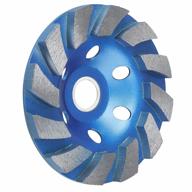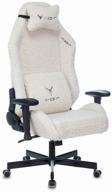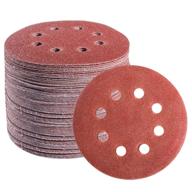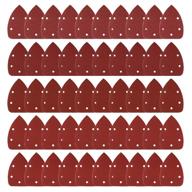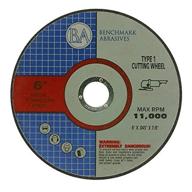Similar products
How to use a diamond cup grinding wheel on concrete?
Diamond cup grinding wheels are excellent tools for grinding and polishing concrete surfaces. Here are some tips on how to use them effectively:
1. Choose the right wheel
Select a wheel with the appropriate bond (resin or metal) and grit size for your application. For general grinding, a resin bond wheel with 60-80 grit is a good choice. For polishing, move up to 200-400 grit resin or metal bond wheels.
2. Use the proper wheel size
Larger diameter wheels cover more surface area. 4-7 inch wheels are common for handheld grinders. Match the wheel size to your tool's specs for best performance.
3. Wear safety gear
- Safety goggles
- Dust mask
- Ear protection
- Gloves
Concrete grinding produces a lot of dust. Protect yourself appropriately.
4. Let the wheel do the work
Apply light, consistent pressure as you move the grinder across the concrete surface. Don't push too hard or the diamonds will glaze over.
5. Keep the wheel face flush
Hold the grinder flat to maximize contact with the concrete. Grinding on an angle will degrade performance.
6. Clean the wheel regularly
Blow or tap the wheel to remove debris and prevent clogging. If glazing occurs, dress the wheel with a specially designed dressing stone.
Following these tips will help you safely and effectively use a diamond cup wheel to grind and polish concrete surfaces.
How to prevent a diamond cup wheel from glazing over?
Glazing occurs when the diamonds on a cup wheel become clogged with debris and stop cutting effectively. It's a common problem that can significantly degrade grinding performance. Here are some tips to help prevent your diamond cup wheels from glazing over:
1. Select the proper grit size
Using too fine of a grit wheel on hard concrete can lead to glazing. For general grinding, start with a more aggressive 60-80 grit wheel. Move up to 200-400 grit for polishing work.
2. Don't push too hard
Applying excessive pressure when grinding can cause the diamonds to smear over and glaze. Let the wheel do the work by using light, consistent pressure across the concrete surface.
3. Keep the wheel face flush
| Flush | Angled |
|---|---|
| Maximizes diamond exposure and cutting action. | Limits number of diamonds in contact with concrete, accelerating glaze. |
Grinding on an angle reduces diamond contact and hastens glazing. Keep the wheel flat and level.
4. Use wet grinding methods
Cooling the wheel with water prevents overheating of the bonds and diamonds. This reduces loading and glazing.
5. Clean the wheel often
Regularly blow or tap the wheel to remove swarf, debris, and dust. This simple maintenance prevents diamond clogging.
6. Dress the wheel when needed
If glazing occurs, use a dressing stone specially designed for diamond cup wheels to expose fresh cutting surfaces.
Follow these guidelines to maintain free-cutting action and optimal performance from your diamond cup wheels. Taking steps to avoid glazing will extend wheel life and produce better grinding results on concrete.
How to choose the right grit size diamond cup wheel?
Selecting the proper grit size is important for diamond cup wheels to work efficiently on concrete. Consider these factors when choosing grit size:
1. Application
- Lower grit (60-80) for aggressive grinding and removal
- Medium grit (100-200) for general purpose grinding
- Higher grit (300-500) for polishing and finishing
2. Concrete hardness
Harder concrete requires smaller grit sizes. Softer concrete can be worked with larger grit sizes.
| Concrete Hardness | Grit Size |
|---|---|
| Soft | 60-100 |
| Medium | 80-200 |
| Hard | 100-400 |
3. Depth of grind
Larger grit sizes remove less material per pass. Use smaller grit for deeper grinding cuts.
4. Finish level
Larger grits leave coarser finishes. Choose finer grit wheels for polished finishes.
5. Wheel bond
Softer resin bonds work well with fine grits for polishing. Harder bond types suit lower grits for grinding.
Considering these factors will ensure you select the optimum diamond cup wheel grit for your concrete grinding needs.
How to safely change a diamond cup grinding wheel?
Changing out a diamond cup wheel on a grinder can be hazardous if proper precautions aren't taken. Follow these safe practices for removing and installing wheels:
Turn off and unplug the grinder
Ensure power is disconnected before attempting to change the wheel. This prevents accidental startup while your hands are near the spinning components.
Wear protective gear
- Eye protection
- Thick work gloves
Diamond cup wheels can fragment or shed segments during change-out. Gear up for safety.
Inspect the new wheel
Check for cracks or damage before mounting. Ensure the wheel dimensions match the grinder specifications.
Remove the grinding guard
The guard must be taken off to access the retaining nut and swap wheels. Be careful not to loosen any other components.
Hold the wheel securely
Firmly grip the wheel to prevent slipping while loosening the nut. Use a wrench to turn the nut counterclockwise.
Mount the new wheel
Thread the locking nut 2-3 turns by hand until tight. Do not overtighten. Reinstall the guard before use.
Perform a test run
Power up the grinder briefly to verify safe operation before grinding. Watch for vibrations or wobbling.
Adhering to safe wheel changing procedures reduces the chance of injury and ensures optimal performance from the diamond cup wheel.







